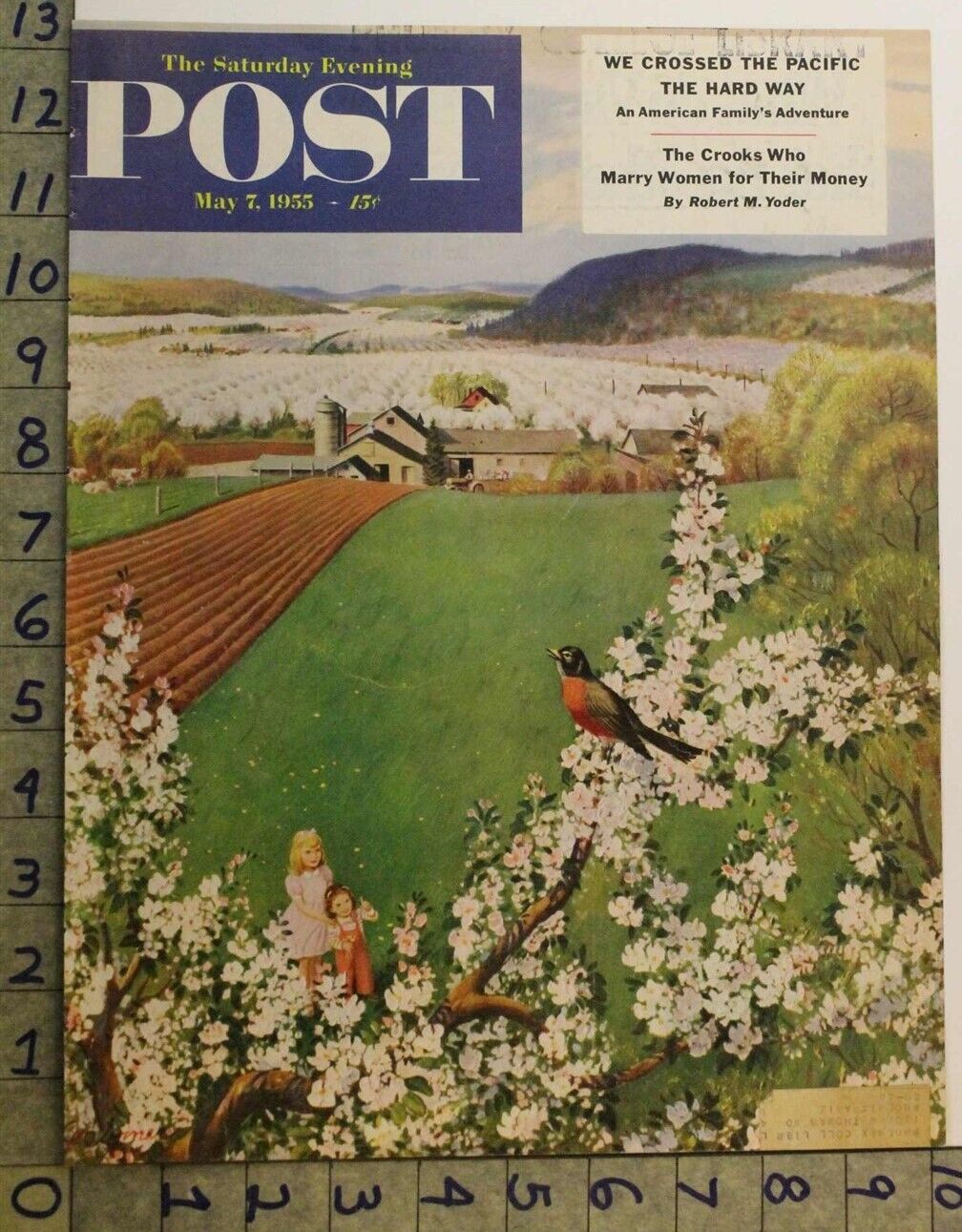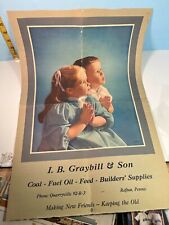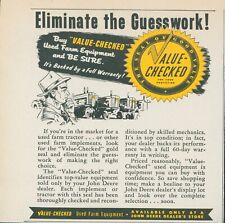1955 FARM APPLE CHERRY ORCHARD ROBIN AGRICULTURE JOHN CLYMER ART COVER 29870 For Sale

When you click on links to various merchants on this site and make a purchase, this can result in this site earning a commission. Affiliate programs and affiliations include, but are not limited to, the eBay Partner Network.
1955 FARM APPLE CHERRY ORCHARD ROBIN AGRICULTURE JOHN CLYMER ART COVER 29870:
$21.95
1955 FARM APPLE CHERRY ORCHARD ROBIN AGRICULTURE JOHN CLYMER ART COVER 29870 DATE OF THIS**ORIGINAL** ILLUSTRATED COVER:1955
SPECIAL CHARACTERISTICS/DESCRIPTIVE WORDS:
The Saturday Evening Postis an Americanmagazine, currently published six times a year. It was issued weekly under this title from 1897 until 1963, then every two weeks until 1969. From the 1920s to the 1960s, it was one of the most widely circulated and influential magazines within the American middle class, with fiction, non-fiction, cartoons and features that reached two million homes every week. The magazine declined in readership through the 1960s, and in 1969The Saturday Evening Postfolded for two years before being revived as a quarterly publication with an emphasis on medical articles in 1971. As of the late 2000s,The Saturday Evening Postis published six times a year by the Saturday Evening Post Society, which purchased the magazine in 1982. The magazine was redesigned in 2013.
HistoryRiseThe Saturday Evening Postwas first published in 1821in the same printing shop at 53 Market Street in Philadelphia where theBenjamin Franklin-foundedPennsylvania Gazettehad been published in the 18th century.While theGazetteceased publication in 1800, ten years after Franklin\'s death, thePostlinks its history to the original magazine.
HeydayThePostgrew to become the most widely circulated weekly magazine in America. The magazine gained prominent status under the leadership of its longtime editorGeorge Horace Lorimer(1899–1937).
The Saturday Evening Postpublished current event articles, editorials, human interest pieces, humor, illustrations, a letter column, poetry (with contributions submitted by readers), single-panel gagcartoons(includingHazelbyTed Key) and stories by the leading writers of the time. It was known for commissioning lavish illustrations and original works of fiction. Illustrations were featured on the cover and embedded in stories and advertising. SomePostillustrations continue to be reproduced as posters or prints, especially those byNorman Rockwell.In 1954 it published its first articles on the role of the US in deposingMohammad Mosaddegh,Prime Minister of Iran, in 1953. The article was based on materials leaked byCIAdirectorAllen Dulles.
DeclineThePostreadership began to decline in the late 1950s and 1960s. In general, the decline of general interest magazines was blamed on television, which competed for advertisers and readers\' attention. ThePosthad problems retaining readers: the public\'s taste in fiction was changing, and thePost\'s conservative politics and values appealed to a declining number of people.Content by popular writers became harder to obtain. Prominent authors drifted away to newer magazines offering more money and status. As a result, thePostpublished more articles on current events and cut costs by replacing illustrations with photographs for covers and advertisements.
Curtis Publishing Co. v. ButtsThe magazine\'s publisher,Curtis Publishing Company, lost a landmarkdefamationsuit,Curtis Publishing Co. v. Butts388 U.S. 130(1967),resulting from an article, and was ordered to payU.S.$3,060,000 indamagesto theplaintiff. ThePostarticle implied thatfootballcoachesPaul \"Bear\" BryantandWally Buttsconspired tofixa game between theUniversity of Alabamaand theUniversity of Georgia. Both coaches sued Curtis Publishing Co. for defamation, each initially asking for $10 million. Bryant eventually settled for $300,000, while Butts\' case went to theSupreme Court, which held thatlibeldamages may be recoverable (in this instance against a news organization) when the injured party is a non-public official, if the plaintiff can prove that the defendant was guilty of a reckless lack of professional standards when examining allegations for reasonable credibility. (Butts was eventually awarded $460,000.)
William Emersonwas promoted to editor-in-chief in 1965 and remained in the position until the magazine\'s demise in 1969.
ClosureIn 1968,Martin Ackerman, a specialist in troubled firms, became president of Curtis after lending it $5 million. Although at first he said there were no plans to shut down the magazine, soon he halved its circulation, purportedly in an attempt to increase the quality of the audience, and then subsequently did shut it down.In announcing that the February 8, 1969, issue would be the magazine\'s last, Curtis executive Martin Ackerman stated that the magazine had lost $5 million in 1968 and would lose a projected $3 million in 1969.In a meeting with employees after the magazine\'s closure had been announced, Emerson thanked the staff for their professional work and promised \"to stay here and see that everyone finds a job\".
At a March 1969post-mortemon the magazine\'s closing, Emerson stated thatThe Post\"was a damn good vehicle for advertising\" with competitive renewal rates and readership reports and expressed whatThe New York Timescalled \"understandable bitterness\" in wishing \"that all the one-eyed critics will lose their other eye\".Otto Friedrich, the magazine\'s last managing editor, blamed the death ofThe Poston Curtis. In hisDecline and Fall(Harper & Row, 1970), an account of the magazine\'s final years (1962–69), he argued that corporate management was unimaginative and incompetent. Friedrich acknowledges thatThe Postfaced challenges while the tastes of American readers changed over the course of the 1960s, but he insisted that the magazine maintained a standard of good quality and was appreciated by readers.
ReemergenceIn 1970, control of the debilitated Curtis Publishing Company was acquired from the estate ofCyrus Curtisby Indianapolis industrialistBeurt SerVaas.SerVaas relaunched thePostthe following year on a quarterly basis as a kind ofnostalgiamagazine.
In early 1982, ownership of thePostwas transferred to the Benjamin Franklin Literary and Medical Society, founded in 1976 by thePost\'s then-editor, Dr. Corena \"Cory\" SerVaas(wife of Beurt SerVaas).The magazine\'s core focus was now health and medicine; indeed, the magazine\'s website originally noted that the \"credibility ofThe Saturday Evening Posthas made it a valuable asset for reaching medical consumers and for helping medical researchers obtain family histories. In the magazine, national health surveys are taken to further current research on topics such ascancer,diabetes,high blood pressure,heart disease,ulcerative colitis,spina bifida, andbipolar disorder.\"Ownership of the magazine was later transferred to the Saturday Evening Post Society; Dr. SerVaas headed both organizations. The range of topics covered in the magazine\'s articles is now wide, suitable for a general readership.
By 1991, Curtis Publishing Company had been renamed Curtis International, a subsidiary of SerVaas Inc., and had become an importer of audiovisual equipment.Today thePostis published six times a year by the Saturday Evening Post Society, which claims501(c)(3)non-profit organizationstatus.
With the January/February 2013 issue, thePostlaunched a major makeover of the publication, including a new cover design and efforts to increase the magazine\'s profile, in response to a general public misbelief that it was no longer in existence. The magazine\'s new logo is an update of a logo it had used beginning in 1942.As of October 2018, the complete archive of the magazine is available online.
The heyday of the Saturday Evening Post is now quite a few years behind us, but the magazine held such a large audience in America that most people are still familiar with it today. Let’s play a little word association: Saturday Evening Post — umm, Norman Rockwell! Yes, that’s right, but there’s so much more to the story of the Post than just Rockwell. There is Curtis and Lorimer and Leyendecker, three names that should at least reign equal with Rockwell’s. We’ll take a look at what each of these names meant to the Post on this page.
The history of the Saturday Evening Post is in itself a tidy history of the magazine in America.
The Saturday Evening Post began in 1821, but as if that didn’t date far enough back to impress you it is claimed that it started up in the same printer’s shop that Ben Franklin’sPennsylvania Gazettebegan in in 1728. Is that American enough for you? Anyway, as collectors we are not all that interested in these early days of the Saturday Evening Post other than as supplemental background information. Where our interest begins to pique is still pretty far back though, in 1897, when Cyrus H.K. Curtis purchased the Post for $1,000.
Cyrus CurtisWhere Curtis’ genius as publisher lay was in his hands-off attitude towards his magazines. He had already implemented this strategy in running his first magazine, the Ladies’ Home Journal. Originally just a column called “Women and the Home” in his newspaper theTribune and Farmer, the Ladies’ Home Journal became a separate supplement to the paper in December 1883. Curtis’ wife, Louisa Knapp, edited it until her resignation in 1889. That’s when Curtis gave it over to his first editorial all-star, Edward William Bok.
As for the Saturday Evening Post, Curtis was taking over a sinking ship. Ad revenue from the publication was just $7,000 in the year Curtis purchased it. Thirty years later, in 1927, ad revenue would top $50,000,000. Cy Curtis resurrected the Saturday Evening Post and made it both the most read and most beloved magazine in America during the 1920’s and 30’s. But before those successes he needed to find an editor.
George Horace Lorimer was brought in to run the Post while Curtis sailed to Europe in search of his new editor. When Lorimer sent Curtis an issue in order to keep his boss informed of how he was handling things, Curtis realized that he already had his man. George Horace Lorimer would be the editor of the Saturday Evening Post from 1899 through 1936. When he took over the circulation of the Post was just over 2,000 copies. Under Lorimer not only would it be the first magazine with a circulation surpassing 1,000,000 copies, it would push itself over the 3,000,000 mark by the end of his tenure.What did Lorimer do to cause this amazing turn around? He implemented changes almost immediately. The September 30, 1899 issue would be expanded to 30 pages and for the first time have a separate cover. Previously the cover of the magazine was page 1. Lorimer produced a two-color red and black cover featuring a painting by George Gibbs. By adding a cover Lorimer was also creating three prominent empty pages: the inside of the front cover and both sides of the back cover. These pages were filled with advertising.
Inside the Saturday Evening PostAdvertising would fuel the success of the Saturday Evening Post. The bottom line for magazines in the past had been circulation–getting paid for selling copies. The Post under Curtis sold for just a nickel to boost circulation numbers and then made its real profits on the advertising. By the teens issues would fatten to over 200 pages and would contain up to 60% advertising. That’s how Curtis and Lorimer managed to hit that magic $50,000,000 ad revenue number by the late twenties.
Inside the covers of the Post was fiction targeted at the masses. The fiction of the Saturday Evening Post was not highbrow like The New Yorker or even literary like Harper’s and the Atlantic. It was popular, intended to strike a chord with the most possible people, not the most educated. The magazine would publish fiction by famous writers such as F. Scott Fitzgerald, Ring Lardner, and Sinclair Lewis, but the main offerings of the Post were popular pieces by writers who are lesser known today: Albert Payson Terhune, Octavus Roy Cohen, Mary Roberts Rinehart and Clarence Budington Kelland were all short story and serialized regulars in thePost.
Besides it’s fiction the Saturday Evening Post offered feature stories and humor. When founded in the 19th Century the Post proclaimed itself neutral in politics, under Lorimer it would take on the editor’s pro-business, Republican personality.
Probably the main competition of the Post would become Collier’s when it was under William Chenery. Collier’s had been founded in 1888 and survived until 1957. They were a heavily fiction based magazine though they also did some muckraking in their features.
Saturday Evening Post CoversBut where the Saturday Evening Post separated itself from Collier’s and other competitors was by cementing its own identity through those famed covers. At first a lot of the covers would contain an illustration which corresponded in some way to one of the stories or features inside. Lorimer would quickly abandon this strategy and instead select covers which evoked those same masses with whom he was trying to connect the contents to. He let the covers stand out as a representation of the magazine as a whole. Each issue of the Saturday Evening Post was intended from cover to cover and contents included to represent the same America that its readers were living in.
The cover artists are some of the most famous illustrators of the 20th Century. Besides Rockwell there was J.C. Leyendecker, Harrison Fisher, James Montgomery Flagg, Steven Dohanos, Mead Schaffer and many others over the years. This page is intended more as an overview of the Saturday Evening Post as a whole, but those artists will be detailed on another part of the site. Following is just a brief overview of their relationship to the Post.
Prior to Rockwell’s emergence, Leyendecker was the top cover artist at the Post. Leyendecker handled most of the holiday covers from the very beginning, his most famous being his New Year’s covers which began featuring his New Year’s Baby with the December 29, 1906 issue. Over time Leyendecker would be credited with over 300 of the Post’s covers.
Norman Rockwell’s first Post cover was the May 20, 1916 issue. He would be the top cover artist at the Saturday Evening Post for most of the rest of the magazines history, inking his last cover with the May 25, 1963 issue. Rockwell’s style was the narrative illustration, pictures which told a story. Probably his most famous cover was the May 29, 1943 issue featuring Rosie the Riveter. It was Rosie’s only appearance on a Post cover.
Leyendecker and Rockwell were definitely the main cover contributors during the magazines glory years. Between the two of them they were responsible for one-third of all covers during the 1920’s as well as the top two contributors in the 30’s. Rockwell had the credit on the Post’s first four-color cover, February 6, 1926. Leyendecker kept up his holiday covers until his last, January 2, 1943.
The Post in the 1930’s and 40’sAs for the men in charge, the Saturday Evening Post continued to be run by the Curtis Company, but Cyrus Curtis himself died in 1933. George Horace Lorimer stayed on as editor well into the 1930’s, but was severely disappointed both in general and with the Post’s readership by the re-election of Franklin D. Roosevelt in 1936. Having run the Post for so many years as a pro-business Republican, Lorimer was disillusioned by the changing times and stepped down as editor at the end of 1936.
Wesley Stout took over with the first issue of 1937. Stout was in a tough position. As was only natural, he wanted to leave his own mark on the Post, but at the same time how could he alter Lorimer’s policies without upsetting the successful magazine? Stout stuck with Leyendecker and Rockwell as cover artists but tried out a host of new illustrators on the issues that weren’t handled by the top pair. Stout also brought the photographic cover back to the Post, using the work of Ivan Dmitri. Even Dmitri’s photographs would bring their own style to the Post, as they were usually close-ups, often snapped from strange angles. Leyendecker and Rockwell would outlast Stout’s tenure.
Issues of the Post had been shrinking since the Depression. Since the size of the magazine was predicated largely upon advertisements it’s quite clear that the shrinking size of the Post meant shrinking ad revenue for the Curtis Company. Stout was out, Ben Hibbs was in. Hibbs would preside over the Post from 1942 through 1961. He quickly changed the logo of the Post. After the War Hibbs selected covers that depicted the American post-war world; this meant lots of cars and views of the suburbs. Family continued to be the key element to which the Post would appeal.
Hibbs tried out new artists as well, but he quickly settled on a few and he stuck with them. During a four year period in the late 1940’s he would use only 16 different cover artists and only half of those would contribute on a regular basis. Besides Rockwell key cover artists under Hibbs were Mead Shaeffer, Steven Dohanos, and Constantin Alajalov. It was also during the 1950’s that Rockwell would begin doing some portrait covers.
The Demise of the Saturday Evening PostProfits for the Saturday Evening Post fell throughout the 50’s. Hibbs would be replaced in 1961 by Robert Fuoss. He implemented a new logo, but both the logo and Fuoss’ time in charge would be short. During the 1960’s the Post forsook a key element of its personality as it shifted to photographic covers. It wasn’t this loss that killed the Post though, just like LIFE and LOOK a great deal of the credit to the demise of The Saturday Evening Post can be handed to television. The last issue was February 8, 1969.
The Post would return in the 1970’s as a nostalgia magazine. It even had the original logo and would sometimes reprint Rockwell and Leyendecker covers. But the Saturday Evening Post that we are going to concern ourselves with as collectors is that original Curtis Post, 1897-1969, a good long life.
ILLUSTRATOR/ARTIST:
John Clymer began his life on the west coast, but spent much of his career out east working in illustration and advertising. Born in Ellensburg, Washington in 1917, Clymer grew up fascinated by natural art at the foothills of the Cascade Mountains. Over the course of his life, he nurtured his love of nature and eventually became most famous for his depictions of the iconic American west. His parents, John and Elmira Clymer, lived simple lives owning a greenhouse and florist business together.
John was not an academic child. He preferred doodles and staring at the landscape outside the classroom window over paying attention to adults. In his youth, the local Presbyterian pastor halted his own sermon to tell John, who was sitting in the back, to stop drawing in the hymnals.
ADVERTSIZE:SEE RULER SIDES IN PHOTO FOR DIMENSIONS ( ALL DIMENSIONS IN INCHES)
**For multiple purchases please wait forour combined invoice.Shipping discountareONLYavailable with this method. Thank You.
Our AD\'s and COVER\'Sare ORIGINAL and 100% guaranteed --- (we code all our items to insure authenticity) ---- we stand behind this.
IF YOU WISH TO PURCHASE A RE-MASTERED COPY PLEASE SEE \"MODERN POSTERS\" IN OUR STORE.
As graphic collectors ourselves, we take great pride in doing the best job we can to preserve and extend the wonderful historic graphics of the past.
PLEASE LOOK AT OUR PHOTO CLOSELY ASIT IS (ALBEIT LOWER RESOLUTION) THE PRODUCT BEING SOLD.....NOT STOCK IMAGES
**NOTE** : PAGES MAY SHOW AGE WEAR AND IMPERFECTIONS TO MARGINS, WITH CLOSED NICKS AND CUTS, WHICH DO NOT AFFECT AD IMAGE OR TEXT WHEN MATTED AND FRAMED. SOMETIMES THE PAGES HAVE BEEN TRIMMED.. PLEASE NOTE THE ACTUAL SIZE OF SELLING AD IN THE ATTACHED PHOTO IMAGE... WHAT YOU SEE IS WHAT YOU GET...
Weship viaUnited States Postal Service.We have a4 day handling time not including weekends or holidays but normally we have all orders processed, packed and shipped within 48 hrs.
A Note to our international buyers (Including Canada). Please read before placing a offer or buying an item:
**Import taxes, duties and charges are not included in the item price or shipping charges. These charges are the buyer\'s responsibility. Please check with your country\'s customs office to determine what these additional costs will be prior to offerding/buying on items. These charges are normally collected by the shipping company or when you pick the item up,this is not anadditionalshipping charge. We are not responsible for shipping times to international buyer\'s. Your country\'s customs may hold the package for a month or more.
**We pride ourselves on quality products, great service, accurate gradationsand fast shipping.**
BRANCHWATER BOOKS
YOUR AD WILL BE SHIPPED ROLLED IN APROTECTIVE PLASTIC BAG INAN 80mm (TWICE USPSRECOMMENDED) THICK, 2 INCHESIN DIAMETER (SO AS NOT TO STRESS THE PAPER)SHIPPING TUBE WITH PRESS TIGHT PLASTIC END CAPS.
29870
Powered by SixBit\'s eCommerce Solution

Related Items:
1955 Ohio Farm License Plate - 43559 - Partial Repaint
$15.00
1955 Farm Coal Lumber & Supplies Poster w/ Years Budget Back Side
$35.09
1955 John Deere Value Checked Seal Good Value Used Farm Vintage Print Ad FJ1
$11.99



